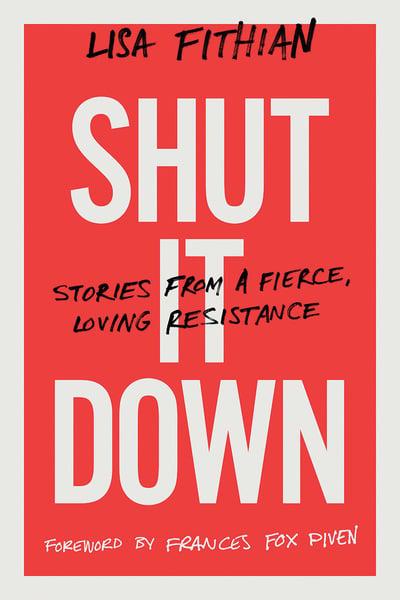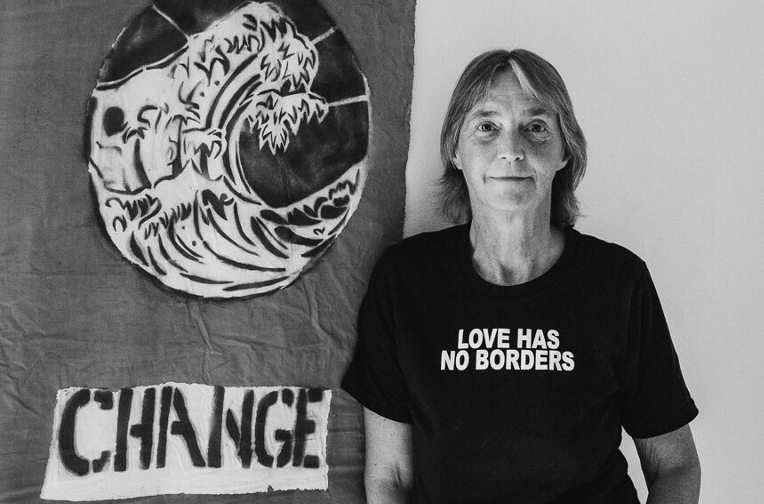 The following excerpt is from Lisa Fithian’s new book Shut It Down: Stories From a Fierce, Loving Resistance (Chelsea Green Publishing, September 2019) and is reprinted with permission from the publisher.
The following excerpt is from Lisa Fithian’s new book Shut It Down: Stories From a Fierce, Loving Resistance (Chelsea Green Publishing, September 2019) and is reprinted with permission from the publisher.
The Power of Healing
By Lisa Fithian
When I was involved with Rise Up Texas in 2013, we offered our people a trauma workshop run by the International Center for Mental Health and Human Rights, which has worked with victims of violence around the world, particularly in Tibet. I learned more about neurology and physiology, and that trauma is not the triggering event itself, but the state of our nervous system during and after. They talked about our optimal window of arousal, or the window of tolerance, an idea first put forth by Dr. Daniel Siegal, a professor of psychology at UCLA.
The optimal window describes the mind-space where we’re best able to notice our sensations, access our emotions, and choose how to respond instead of just reacting. In this space we are grounded, clear, and calm.
This optimal window contrasts with times when we are hyper-regulated (anxious, agitated) or hypo-regulated (depressed, apathetic). I’ve found that these three states correspond very well with the three types of power—Power Over, Power With/Within, and Power Under. Inspired by a framework that the international center offered, I now use these descriptions in some of my trainings:
Hyper-Aroused
ASSOCIATED WITH: Anger—Power Over—Superiority
WORD ASSOCIATIONS: Anxious, stress, agitated, manic, inflated, angry,
talking fast, interrupting, no focus, no listening, no logic, buzzed, tense, seeing red, vengeful
Optimal Window of Arousal
ASSOCIATED WITH: Centered—Power With—Power Within
WORD ASSOCIATIONS: Sacred, open, grounded, fully alive, flexible, flow,
non-attachment, light on feet, in the moment, needs met, clarity, hopeful, open to possibilities, clear, calm, rested, relaxed, generous, confident, capable, powerful, patient, kind, delighted, welcoming, breathing
Hypo-Aroused
ASSOCIATED WITH: Fear—Power Under—Inferiority
WORD ASSOCIATIONS: Tired, numb, depressed, apathetic, deflated,
dissociated, lethargic, dull, worried, withdrawn, depressed, sleeping, paranoid, non-motivated, defeated, defensive
Trauma starts within our limbic system, the oldest part of the brain that enables us to respond to threats and processes our base instincts and emotions. Our limbic system commands our social feelings—our deep need to belong to community, which can in fact be the difference between life and death. When we’re threatened, our limbic system is activated in a big way. When the threat passes, the system should return to baseline. But for many of us living with trauma, it does not.
Psychologist Peter Levine was one of the first to develop somatic healing methods by focusing on how the body manifests trauma at the physiological level. In the landmark book Waking the Tiger: Healing Trauma, Levine describes how animals in the wild are able to shake out the residual energy from the limbic system’s reaction to threat, discharging it, returning their bodies to a state of equilibrium. The problem with humans is we’re not so good at that. The trauma gets embedded; our alert system gets stuck, leaving us constantly on alert, afraid, and unable to calm ourselves.
Post-traumatic stress disorder is what this triggered, reactive state is called. There are many techniques that are proving helpful for PTSD, like Eye Movement Desensitization and Reprocessing (EMDR) therapy, tapping, yoga, and shaking your body. The difficulty is, our modern environment too rarely offers the conditions we need to support our healing from trauma and to develop in healthy ways. Over the millennia, our survival was based on being part of a group—a herd, pack, clan, or tribe. The threats are not the same today, but our wiring is the same. From birth onward, we learn to be dependent, and then interdependent. The ability to develop what is known as secure attachment is at the core of all relationships and our navigation of the insider/outsider dynamic. We aren’t usually conscious of it, but at some level we’re always assessing/asking: Do I belong? Is it safe? Will I be accepted? Am I loved? Even in movement work, understanding this dynamic is key to how we organize our meetings and events. We want everyone to feel like they belong.
When people lack the social conditions or other resources to develop secure attachment or for moving themselves back to a state of equilibrium, they learn to feel better by reaching outside themselves for something to calm the pain. The common choices are alcohol, drugs (legal and illegal), nicotine, caffeine, but also shopping, overeating, television addiction, workaholism—any behavior that we overdo to escape the pain. Even behaviors like reading or exercise can become addictive and can keep us disconnected when we overdo them. These addictions become a vicious cycle. When we’re caught up in avoiding pain, we’re less able to act with clarity, maturity, and compassion, or from a place of security when dealing with other people, thus creating increased insecurity and pain.
One of the first steps to healing is simply being conscious of what is. In our culture many of the symptoms of Hyper-Arousal are rewarded and even celebrated, like overwork, while the symptoms of Hypo-Arousal (depression, lethargy) are shamed and thus people try to hide it. We all experience trauma at some level; it is impossible to escape in a country founded in colonization, white supremacy, patriarchy, and capitalism. For generations, people have lived with state violence and environmental destruction, passing their trauma on to the next generation. The dominant culture can make us sick on any given day, whether from environmental toxins, pharmaceuticals, or pollutants in the water, air, and land. This is particularly true for people of color, whose very survival is challenged daily.
In a culture where violence is glorified and all around, we are consciously and unconsciously afraid of what we might lose or have taken from us. Strategies for getting back to center include:
Asking for help
Eating well
Sleeping well
Developing self-awareness with breathing exercises, identifying
emotions and sensations, and taking the time to scan and notice your
body and what it’s feeling
Learning to meditate
Taking long walks (this can reset your body)
Physical activity and exercise, especially yoga and dance
Connecting with someone safe and loving
Being easy on yourself and indulging in time-outs
Making eye contact with others, gazing into the other beings around
you, recognizing their beauty and light
Doing things that make you happy—playing with babies, physical
intimacy, and connecting with nature
With consent, we can offer others a hug, a gentle touch to the shoulder,
or hold hands
Educating yourself about healing techniques
Being attentive to yourself and your personal hygiene
Connecting with friends, and community. Seek out teachers and
healers—they are everywhere!
Another tool that I’ve found helpful for healing work is the practice of nonviolent communications (NVC) developed by Marshall Rosenberg. Oppression and trauma can lead to unhealthy communication, as it can cut us off from what we feel, need, or want. NVC offers us some literacy on emotions and needs. If you aren’t feeling good about a dynamic with some- one, you can follow this conversation process: (1) Say, “I noticed that . . .” (2) Ask, “How did it make you feel?” (“I felt . . .”) (3) Ask, “What do you need?” (“What do I need . . .”) (4) Make a request. “Would you . . .” This simple, elegant process can remove judgment and anger, and it can get to the heart of what you feel and what you need to heal the disconnection.
I recognize that there are many other ways to achieve health and fight disease, and we cannot underestimate the power of staying active, eating healthy foods, drinking clean water, breathing fresh air, and cleaning up the soil. I’m not trying to oversimplify the many health challenges that people face, but rather to offer suggestions that can help make life healthier and more rewarding. There is no one way to heal but many, so finding what works for you is what matters.
During the process of writing my book Shut It Down, I have been learning what it means to truly love and accept myself, knowing that I am enough just the way I am. Sometimes this just means knowing what I am feeling, needing, and wanting and being gentle with myself. From all of my learnings, I am hopeful. Here again, complexity science informs my understanding—we are amazing, complex beings made up of many systems that are always interacting and changing. That change can lead us to destruction and death, or to an ever-evolving process of wholeness and health. We are never done, because we are in relationship with an environment that is always changing. We in fact emerge new each day.





